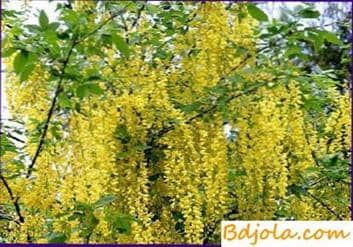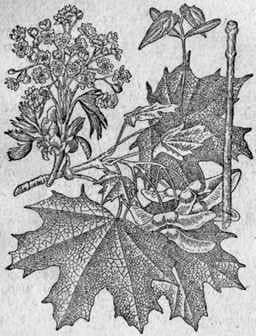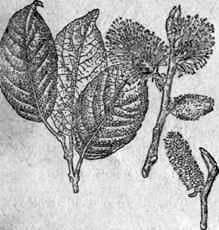Wood and shrub melliferous plants

Of the woody honey plants, white acacia, maple, linden, gledicia, willow and fruit trees are of the greatest importance.
Acacia white – a tree, reaching a height of more than 20 m, has a variety, characterized by the shape of the trunk, crown, leaves (mast, pyramidal, Besson, having a spherical shape of the crown). Acacia grows mainly in the south, reaching north to Voronezh – Kursk. Individual specimens are found in Moscow. In Ukraine it grows everywhere.
Acacia white – a very fast growing tree, undemanding to the soil, gives the business a very solid wood and deserves much attention, although it strongly clogs the soil. It grows well on the steep slopes of ravines and gullies.
By the amount of nectar released, it is one of the best honey plants. If there is a sufficient amount of white acacia during its flowering, apiaries usually get commodity honey. It is believed that a hectare of acacia, in favorable weather, releases over a thousand kilograms of nectar. Blossoms of white acacia in late May, but often because of the changing weather of bribes from it is unstable.
Honey with white acacia is considered one of the best, in liquid form it is almost transparent. After the cage becomes white and fine-grained.
Maple.
Various species of maple, more often tree-like, less often shrubby, are widespread in our forests and ornamental plantations. A large number of varieties of maples are known. For beekeeping, maple, field and Tatar maples are of the greatest interest.

Fig. Maple leaf.
Maples give bees a lot of nectar and pollen. They are of great importance for the development of bee colonies, since they bloom relatively early, when they are still blooming; few other melliferous plants. In places with large thickets of maple, with special preparation of bee colonies, commodity
Linden.
There are several types of limes: small-leaved, large-leaved, Amur, manzhurian, linden Tacketa. Honey from linden flowers is one of the best and is widely known.

Fig. Lime-leaf small-leaved.
Gledicia vulgaris is a large tree 20-25 m high. The trunk and branches carry long and strong spines, but non-friable forms are also known.
Gledicia is of great interest for landscaping settlements, strengthening ravines and gullies and the arrangement of hedges. She easily tolerates the haircut, which should be done in the early spring. Due to the presence of thorns, the hedge is completely impassable.
Gledicia is one of the best honey plants. By the amount of nectar released, among the southern trees, it is second only to the white acacia and gives bees, a good bribe. Blooming in late May, the gladichia blooms in small greenish flowers throughout the first half of the summer. Of the fruit trees, honey-bearing are: apricot, cherry, pear, or forest, apple forest, Chinese apple, cherry plum, cherry, plum.
Among shrubs for beekeeping, especially important are: willow, acacia yellow, honeysuckle, goldencurrant, gooseberry, narrow-leaved eel, scullia, etc.).
Willows are ubiquitous shrubs and trees. In our country there are more than 160 species of willow growing in a variety of conditions in all areas of the country, from the north to the far south.

Fig. Iva-bredina.
For each zone it is possible to select the most suitable for the given area early and medium flowering varieties of willows and thus create a steady spring bribe to bees for one to one and a half month.
They plant willow with seeds, cuttings and stakes, as well as transplant small plants from wild thickets. In humid places it very well gets accustomed and grows fast.
Acacia yellow.
A well-known, widespread shrub. In the wild, it occurs in large numbers in Siberia, the Altai and Central Asia. Acacia is undemanding for soil, it also grows on saline soils, but best of all on fresh sandy loam; is drought-resistant. Without trimming, the yellow acacia grows slowly, but after trimming, which is done in the first or second year after planting, it strongly bays and quickly grows.
In the protective plantations is one of the best shrubs. Yellow acacia is widely used for hedges, alleys and ornamental plantations (especially the weeping form).
The flowers of the yellow acacia are beautifully visited by bees and give them a good, stable, comparatively early bribe; it blooms after the flowering gardens.
Often bees suck out the nectar of acacia flowers through damage in the coronals produced by bumblebees, since the depth of the coronas of their flowers presents some difficulties for bees when extracting nectar.
Dilute the yellow acacia seeds, which are recommended to be preliminarily subjected to special treatment: first they are soaked in water for four hours, then they are scattered in a thin layer and covered with snow, under which they leave until the day of planting (can be kept for up to three months). To prevent snow from melting, it is covered with sawdust, straw or peat.
Honeysuckle.
All kinds of honeysuckle are well visited by bees and give bribes at a time when the spring honey-plants are already fading, and summer ones, which usually give the main honey collection, have not yet blossomed. One of the representatives of the species of honeysuckle – snow leopard blooms all summer. All honeysuckle is used for decorative planting. Honeysuckle is used a little, its berries are inedible and attract only birds. The wood is very strong and can go to small crafts. Honeysuckle is seeded with seeds, separated from berries by kneading and washing with water. When sowing in the spring, the seeds are stratified one month before sowing.
Sea buckthorn.
Prickly bush, undemanding soil drought-resistant, especially suitable for hedges.
The fruits of sea-buckthorn are used in the pharmaceutical food industry, as well as in the household for jams, jams, tinctures, etc. The colors of sea-buckthorn are well visited by bees.
Loch is a beautiful wild shrub or tree. Willingly visited by bees.
Amorph is an undemanding shrub to the soil, which can endure long-term flooding and soil salinity. It grows on sandy soils; good honey and pollen.
Wood and shrub melliferous plants
